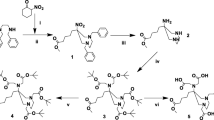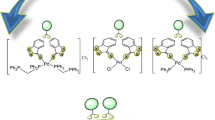Abstract.
The "3+1" ligand system [SN(R)S/S combination] was applied in order to synthesize neutral mixed-ligand oxotechnetium complexes of the general formula 99mTcO[SN(R)S]/[S] as potential 5-HT1A receptor imaging agents. The complexes are carrying the 1-(2-methoxyphenyl)piperazine moiety, a fragment of the true 5-HT1A antagonist WAY 100635, either on the monodentate ligand [S] or on the tridentate ligand [SN(R)S]. The complexes MO[EtN(CH2CH2S)2][o-MeOC6H4N(CH2CH2)2NCH2CH2S] (3), MO[o-MeOC6H4N(CH2CH2)2N(CH2)3N(CH2CH2S)2][PhS] (6) and MO[o-MeOC6H4N(CH2CH2)2N(CH2)3N(CH2CH2S)2][PhCH2CH2S] (9), where M=99mTc, were prepared at tracer level using 99mTc glucoheptonate as precursor. For structural characterization, the analogous oxorhenium (M=Re, 1, 4 and 7, respectively) and oxotechnetium (M=99gTc, 2, 5 and 8, respectively) complexes were prepared by ligand exchange reactions. All products were characterized by elemental analysis and spectroscopic methods. Complexes 1, 4 and 7 were further characterized by crystallographic analysis. For 1, the coordination geometry about rhenium can be described as trigonally distorted square pyramidal (τ=0.36), while for 4 and 7, as distorted trigonal bipyramidal (τ=0.66 and τ=0.61, respectively). The coordination sphere about oxorhenium in all complexes is defined by the SNS donor atom set of the tridentate ligand and the sulfur atom of the monodentate coligand. The structure of the 99mTc complexes 3, 6 and 9 was established by comparative HPLC using authentic oxorhenium and oxotechnetium samples. The binding affinity of oxorhenium compounds for the 5-HT1A receptor subtype was determined in rat brain hippocampal preparations (IC50=6–31 nM). Preliminary tissue distribution data in healthy mice revealed the ability of all three 99mTc complexes to cross the intact blood-brain barrier (0.49–1.15% ID at 1 min p.i.). In addition, complexes 6 and 9 showed significant brain retention. These promising results have demonstrated that the SNS/S mixed-ligand system can be used in the development of 99mTc complexes as potential 5-HT1A receptor imaging agents.
Similar content being viewed by others
Author information
Authors and Affiliations
Additional information
Electronic Publication
Rights and permissions
About this article
Cite this article
Papagiannopoulou, D., Pirmettis, I., Maina, T. et al. Development of novel mixed-ligand oxotechnetium [SNS/S] complexes as potential 5-HT1A receptor imaging agents. J. Biol. Inorg. Chem. 6, 256–265 (2001). https://doi.org/10.1007/s007750000194
Received:
Accepted:
Issue Date:
DOI: https://doi.org/10.1007/s007750000194




